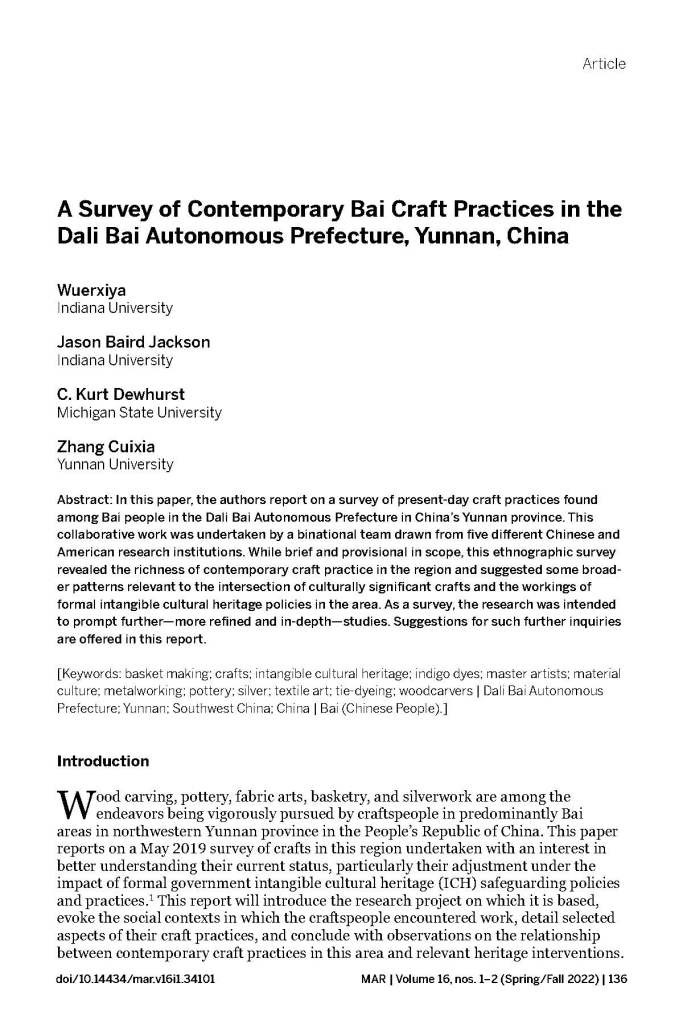A note on photographs. Here just a few photographs from the first day of our May 2019 travel in Yunnan are presented. It will take time to work through all of the images that were made during the travels described in this post. When a fuller report is ready, the team will share additional images.
In May, after the conclusion of the Seventh Forum on China-US Folklore and Intangible Cultural Heritage (where our focus was Collaborative Work in Museum Folklore and Heritage Studies), I was part of a group of American museum folklorists who traveled to the Dali Bai Autonomous Prefecture in China’s Yunnan Province. A spin-off project from the China-US Folklore and Intangible Cultural Heritage Project, our group was very generously hosted by the Institute of National Culture Research at Dali University in the city of Dali (Figures 1-2). Together with members of the Institute’s faculty, we traveled throughout the prefecture meeting Bai craftspeople working in a range of material forms. From them, we learned about their craft disciplines and about their experiences participating in formal intangible cultural heritage initiatives. This opportunity to learn from talented makers in Yunnan offered a wonderful comparative experience, pointing to commonalities and differences with northern Guangxi, where our group has been pursuing collaborative studies with partners from the Anthropology Museum of Guangxi, the Nandan Baiku Yao Ecomuseum and the Sanjiang Dong Ecomuseum.

Figure 1. Dr. CUN Yunji, leader of the Institute of National Culture Research at Dali University, hosts a discussion on heritage research. Participating were faculty, researchers, and students from the Institute and visitors from the three participating institutions in the United States (Michigan State University Museum, Museum of International Folk Art, and the Mathers Museum of World Cultures, Indiana University. May 23, 2019. Photograph courtesy of the Institute of National Culture Research.
A full account of the Dali-area craft survey is in preparation and I am hopeful that we can share it later. Here my aim is to thank our very generous hosts and interlocutors.

Figure 2. Members of the Institute of National Culture Research, Dali University together with the visiting team from the United States. May 23, 2019. Photograph courtesy of the Institute of National Culture Research.
During our time in the Bai region, our bi-national team visited with a silversmith, a wood carver, a ceramicist, an embroiderer who also makes elaborate fabric figures and miniature dioramas on ethnographic topics, two tie-dye artists, and two basket makers. In each case, these craftspeople maintained active studios and most guided the work of many students, apprentices, and junior colleagues. Nearly all were recognized as masters on some formal level (national, prefectural, county, etc.) within China’s system of intangible cultural heritage recognition, promotion, and safeguarding. We also attended a key calendrical festival of regional importance and visited the Three Pagodas of the Chongsheng Temple near (old) Dali (Figures 3-5). While old Dali was our home base, we traveled to many towns and villages and spent one night in old Shaxi. We enjoyed traveling with our colleagues from Dali University and holding discussions with them on areas of shared research interest while visiting the university’s beautiful campus. Many layers of cultural history are evident when traveling in the Dali area. Long favorited by international and Chinese tourists, Dali and the whole region has an elaborate tourism economy and infrastructure, reflective of dramatic and constant change within the period of China’s “opening up” (see for instance, the research of Beth Notar). As throughout the country, one can also see Dali-specific evidence of older historical eras, from the time of the cultural revolution to the republican and imperial eras. In this region, particular emphasis is given (at present) to long-distance trade on the Tea Horse Road. Intercultural connectedness is a theme in tourism and historical consciousness that draws on the story of trade routes, the region’s religious complexity, and its distinctive place in the region’s long history.

Figure 3. Erhai Lake and the Dali Basin as seen from the Dali University campus near Dali (Old Town). May 23, 2019. Photograph by C. Kurt Dewhurst.
I record here our deep appreciation for our generous and knowledgeable colleagues at Dali University and in Yunnan more broadly. Many friends in the Chinese folklore studies community assisted us making this journey. We look forward to sharing the fuller story of this trip and to thanking our partners by name in a more formal report. Special thanks go, of course, to the craftspeople who opened their studios, workshops, and homes to our team of Chinese and American scholars.

Figure 4. A view of The Three Pagodas and the Cang Mountains. May 23, 2019. Photograph by Jason Baird Jackson.

Figure 5. A small glimpse of the very large Chongshen Temple and Monastery complex near (old) Dali. May 23, 2019. Photograph by Carrie Hertz.
















